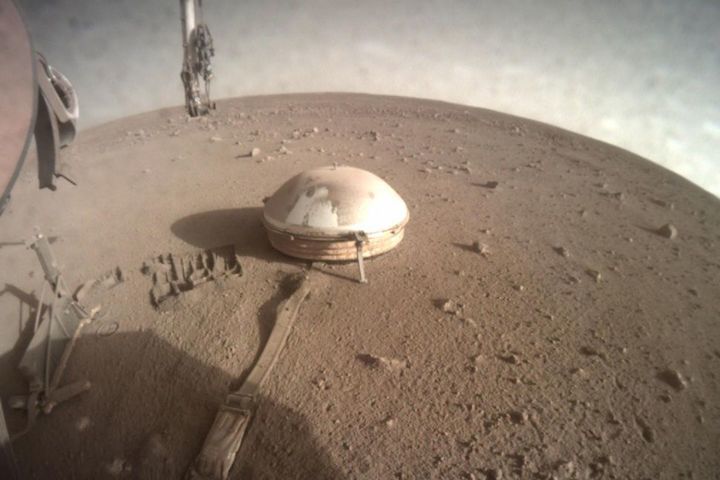15.01.2021
NASA InSight’s ‘Mole’ Ends Its Journey on Mars
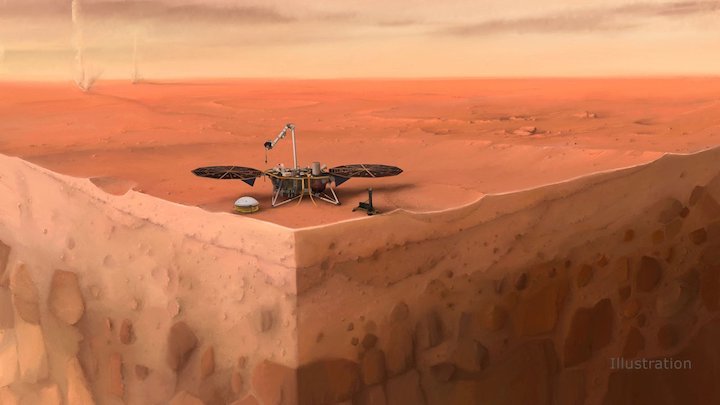
In this artist's concept of NASA's InSight lander on Mars, layers of the planet's subsurface can be seen below, and dust devils can be seen in the background.
Credit: IPGP/Nicolas Sarter
The heat probe hasn’t been able to gain the friction it needs to dig, but the mission has been granted an extension to carry on with its other science.
The heat probe developed and built by the German Aerospace Center (DLR) and deployed on Mars by NASA’s InSight lander has ended its portion of the mission. Since Feb. 28, 2019, the probe, called the “mole,” has been attempting to burrow into the Martian surface to take the planet’s internal temperature, providing details about the interior heat engine that drives the Mars’ evolution and geology. But the soil’s unexpected tendency to clump deprived the spike-like mole of the friction it needs to hammer itself to a sufficient depth.
After getting the top of the mole about 2 or 3 centimeters under the surface, the team tried one last time to use a scoop on InSight’s robotic arm to scrape soil onto the probe and tamp it down to provide added friction. After the probe conducted 500 additional hammer strokes on Saturday, Jan. 9, with no progress, the team called an end to their efforts.
Part of an instrument called the Heat Flow and Physical Properties Package (HP3), the mole is a 16-inch-long (40-centimeter-long) pile driver connected to the lander by a tether with embedded temperature sensors. These sensors are designed to measure heat flowing from the planet once the mole has dug at least 10 feet (3 meters) deep.
“We’ve given it everything we’ve got, but Mars and our heroic mole remain incompatible,” said HP3’s principal investigator, Tilman Spohn of DLR. “Fortunately, we’ve learned a lot that will benefit future missions that attempt to dig into the subsurface.”

The “mole,” a heat probe that traveled to Mars aboard NASA’s InSight lander, as it looked after hammering on Jan. 9, 2021, the 754th Martian day, or sol, of the mission. After trying since Feb. 28, 2019, to bury the probe, the mission team called an end to their efforts. Full Image Details
While NASA’s Phoenix lander scraped the top layer of the Martian surface, no mission before InSight has tried to burrow into the soil. Doing so is important for a variety of reasons: Future astronauts may need to dig through soil to access water ice, while scientists want to study the subsurface’s potential to support microbial life.
“We are so proud of our team who worked hard to get InSight’s mole deeper into the planet. It was amazing to see them troubleshoot from millions of miles away,” said Thomas Zurbuchen, associate administrator for science at the agency’s headquarters in Washington. “This is why we take risks at NASA – we have to push the limits of technology to learn what works and what doesn’t. In that sense, we’ve been successful: We’ve learned a lot that will benefit future missions to Mars and elsewhere, and we thank our German partners from DLR for providing this instrument and for their collaboration.”
Hard-Earned Wisdom
The unexpected properties of the soil near the surface next to InSight will be puzzled over by scientists for years to come. The mole’s design was based on soil seen by previous Mars missions – soil that proved very different from what the mole encountered. For two years, the team worked to adapt the unique and innovative instrument to these new circumstances.
“The mole is a device with no heritage. What we attempted to do – to dig so deep with a device so small – is unprecedented,” said Troy Hudson, a scientist and engineer at NASA’s Jet Propulsion Laboratory in Southern California who has led efforts to get the mole deeper into the Martian crust. “Having had the opportunity to take this all the way to the end is the greatest reward.”
Besides learning about the soil at this location, engineers have gained invaluable experience operating the robotic arm. In fact, they used the arm and scoop in ways they never intended to at the outset of the mission, including pressing against and down on the mole. Planning the moves and getting them just right with the commands they were sending up to InSight pushed the team to grow.
They’ll put their hard-earned wisdom to use in the future. The mission intends to employ the robotic arm in burying the tether that conveys data and power between the lander and InSight’s seismometer, which has recorded more than 480 marsquakes. Burying it will help reduce temperature changes that have created cracking and popping sounds in seismic data.
There’s much more science to come from InSight, short for Interior Exploration using Seismic Investigations, Geodesy, and Heat Transport. NASA recently extended the mission for two more years, to Dec. 2022. Along with hunting for quakes, the lander hosts a radio experiment that is collecting data to reveal whether the planet’s core is liquid or solid. And InSight’s weather sensors are capable of providing some of the most detailed meteorological data ever collected on Mars. Together with weather instruments aboard NASA's Curiosity rover and its new Perseverance rover, which lands on Feb. 18, the three spacecraft will create the first meteorological network on another planet.
More About the Mission
JPL manages InSight for NASA’s Science Mission Directorate. InSight is part of NASA’s Discovery Program, managed by the agency’s Marshall Space Flight Center in Huntsville, Alabama. Lockheed Martin Space in Denver built the InSight spacecraft, including its cruise stage and lander, and supports spacecraft operations for the mission.
A number of European partners, including France’s Centre National d’Études Spatiales (CNES) and the German Aerospace Center (DLR), are supporting the InSight mission. CNES provided the Seismic Experiment for Interior Structure (SEIS) instrument to NASA, with the principal investigator at IPGP (Institut de Physique du Globe de Paris). Significant contributions for SEIS came from IPGP; the Max Planck Institute for Solar System Research (MPS) in Germany; the Swiss Federal Institute of Technology (ETH Zurich) in Switzerland; Imperial College London and Oxford University in the United Kingdom; and JPL. DLR provided the Heat Flow and Physical Properties Package (HP3) instrument, with significant contributions from the Space Research Center (CBK) of the Polish Academy of Sciences and Astronika in Poland. Spain’s Centro de Astrobiología (CAB) supplied the temperature and wind sensors.
Quelle: NASA
----
Update: 4.06.2021
.
NASA’s InSight Mars Lander Gets a Power Boost
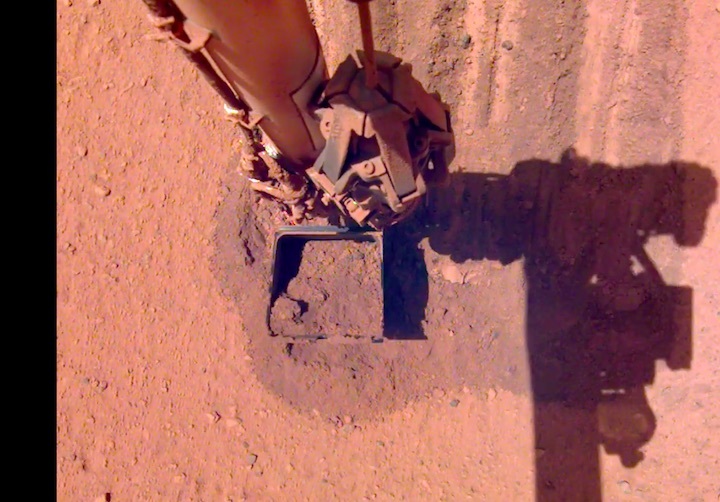
To clean a bit of dust from one of its solar panels, NASA’s InSight lander trickled sand above the panel. The wind-borne sand grains then picked up some dust on the panel, enabling the lander to gain about 30 watt-hours of energy per sol on May 22, 2021, the 884th Martian day of the mission.
The spacecraft successfully cleared some dust off its solar panels, helping to raise its energy and delay when it will need to switch off its science instruments.
The team behind NASA’s InSight Mars lander has come up with an innovative way to boost the spacecraft’s energy at a time when its power levels have been falling. The lander’s robotic arm trickled sand near one solar panel, helping the wind to carry off some of the panel’s dust. The result was a gain of about 30 watt-hours of energy per sol, or Martian day.
Mars is approaching aphelion, its farthest point from the Sun. That means less sunlight reaches the spacecraft’s dust-covered solar panels, reducing their energy output. The team had planned for this before InSight’s two-year mission extension. They’ve designed the mission to operate without science instruments for the next few months before resuming science operations later this year. During this period, InSight will reserve power for its heaters, computer, and other key components.
The power boost should delay the instruments being switched off by a few weeks, gaining precious time to collect additional science data. The team will try to clear a bit more dust from the same solar panel this Saturday, June 5, 2021.
Dust in the Wind
InSight’s team has been thinking up ways to try to clear dust from its solar panels for almost a year. For example, they tried pulsing the solar panel deployment motors (last used when InSight opened its solar panels after landing) to shake the dust off but didn’t succeed.
More recently, several members of the science team started pursuing the counterintuitive technique of trickling sand near – but not directly on top of – the panels. Matt Golombek, a member of the InSight science team at NASA’s Jet Propulsion Laboratory in Southern California, which manages the mission, noted that it might be possible to strike dust on the panels with sand grains that would “saltate,” or hop off the solar panel surface and skip through the air in the wind. The larger grains might then carry off the smaller dust particles in the wind.
To try the technique, the team used the scoop on InSight’s robotic arm to trickle sand next to InSight’s solar panels on May 22, 2021, the 884th sol of the mission, at around noon Mars time – the windiest time of day. It was easiest for InSight’s arm to be positioned over the lander’s deck, high enough for the winds to blow sand over the panels. Sure enough, with winds blowing northwest at a maximum of 20 feet (6 meters) per second, the trickling of sand coincided with an instantaneous bump in the spacecraft’s overall power.
“We weren’t sure this would work, but we’re delighted that it did,” Golombek said.
While it’s no guarantee that the spacecraft has all the power it needs, the recent cleaning will add some helpful margin to InSight’s power reserves.
Surviving on Mars
InSight’s panels have outlasted the two-year prime mission they were designed for and are now powering the spacecraft through the two-year extension. Relying on solar panels for power enables such missions to be as light as possible for launch and requires fewer moving parts – thus, fewer potential failure points – than other systems. Equipping the spacecraft with brushes or fans to clear off dust would add weight and failure points. (Some members of the public have suggested using the Ingenuity Mars Helicopter’s whirring blades to clear off InSight’s panels, but that’s not an option, either: The operation would be too risky, and the helicopter is roughly 2,145 miles, or 3,452 kilometers, away.)
However, as the Spirit and Opportunity Mars rovers showed, gusts and whirlwinds can clear solar panels over time. In the case of InSight, the spacecraft’s weather sensors have detected many passing whirlwinds, but none have cleared any dust.
By August, as Mars moves in its orbit closer to the Sun, InSight’s solar panels should be able to gather more energy, allowing the team to turn the science instruments back on. Depending on the available power, they might begin by turning some on for short periods at key times during the day, as they’ve been doing to save energy.
Whether the instruments are on or off, InSight operations will pause again around Oct. 7, when Mars and the Earth will be on opposite sides of the Sun. Known as Mars Solar Conjunction, this period happens every two years. Because plasma from the Sun can interrupt radio signals sent to spacecraft at that time, all of NASA’s Mars missions will become more passive, continuing to record data and send updates to engineers on Earth, though no new commands will be sent back to them. The moratorium on Mars commands will last several weeks until late October.
More About the Mission
JPL manages InSight for NASA’s Science Mission Directorate. InSight is part of NASA’s Discovery Program, managed by the agency’s Marshall Space Flight Center in Huntsville, Alabama. Lockheed Martin Space in Denver built the InSight spacecraft, including its cruise stage and lander, and supports spacecraft operations for the mission.
A number of European partners, including France’s Centre National d’Études Spatiales (CNES) and the German Aerospace Center (DLR), are supporting the InSight mission. CNES provided the Seismic Experiment for Interior Structure (SEIS) instrument to NASA, with the principal investigator at IPGP (Institut de Physique du Globe de Paris). Significant contributions for SEIS came from IPGP; the Max Planck Institute for Solar System Research (MPS) in Germany; the Swiss Federal Institute of Technology (ETH Zurich) in Switzerland; Imperial College London and Oxford University in the United Kingdom; and JPL. DLR provided the Heat Flow and Physical Properties Package (HP3) instrument, with significant contributions from the Space Research Center (CBK) of the Polish Academy of Sciences and Astronika in Poland. Spain’s Centro de Astrobiología (CAB) supplied the temperature and wind sensors.
Quelle: NASA
----
Update: 24.06.2021
.
Dropping power levels threaten InSight mission
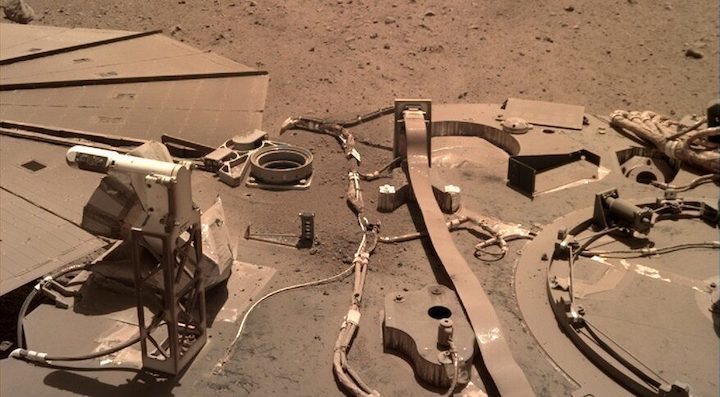
WASHINGTON — Dust accumulation on the solar panels of NASA’s InSight Mars lander is reducing the power to the spacecraft and could force the mission to end within a year.
At a June 21 meeting of NASA’s Mars Exploration Program Analysis Group, Bruce Banerdt, principal investigator for the InSight mission at NASA’s Jet Propulsion Laboratory, said dust accumulating on the lander’s two solar panels has drastically reduced the amount of power they produce, requiring some instruments to be turned off at least temporarily.
“The dust accumulation on the solar arrays has been considerable. We have about 80% obscuration of the arrays,” he said. The amount of energy available to the lander per Martian day, or sol, has dropped from nearly 5,000 watt-hours shortly after its November 2018 landing to less than 700 watt-hours now, according to data Banerdt presented at the meeting.
The decline in energy was expected, and the mission was designed to have enough power for its prime mission, which lasted one Martian year or 687 days. The continued decline in power, though, is becoming an issue as InSight operates in an extended mission funded through the end of 2022 to collect additional seismic data.
Banerdt said the mission had hoped for “cleaning events” where winds remove some of the dust, allowing the panels to generate more power. Such cleaning events allowed the solar-powered Mars Exploration Rovers, Spirit and Opportunity, to operate for years, far longer than expected.
Those cleaning events have not taken place for InSight, though, and other attempts to remove the dust, such as shaking the panels, have failed. More recently, the mission tried a novel approach for cleaning the panels: using the lander’s robotic arm to scoop up regolith and then release it near the panels. Winds allowed some particles to bounce off the panels, in the process removing dust, a process known as saltation.
“We had some success with that,” he said. The first attempt at saltation increased energy output by 25 to 30 watt-hours, he said. A second attempt, though, provided only a temporary increase in energy, and a third attempt last weekend offered “a little bit of an increase.”
“This has bought us a little bit of headroom that we didn’t have before,” he said. Energy levels are dropping because of both the increased dust accumulation as well as Mars nearing aphelion, or the farthest point in its orbit from the sun. Mars will reach aphelion in about two months, after which sunlight, and thus power levels, should increase slightly.
Banerdt said the mission is closely monitoring power levels to determine what systems may need to be turned off as aphelion approaches. “It’s going to be extremely challenging to operate through that, especially with the instruments,” he said.
Some sensors, such as for collecting weather and magnetic field data, have already been turned off, or used only sporadically. “We hope to get some of these instruments up to at least do periodic measurements after aphelion,” he said.
InSight’s main instrument, a seismometer, has remained in operation. Banerdt, though, did not rule out having to turn it off near aphelion. “We may have to power off the entire payload for some period around aphelion,” he said. “There may be a month or two of time where we might have to turn off the seismometer, but we’re trying to tighten our belts and sharpen our pencils to see whether we can operate straight through.”
InSight will get a respite after aphelion as sunlight levels increase, but Banerdt warned it will be temporary. By April 2022, energy levels will decrease further, which he said was due to increased dust accumulation on the panels, more dust in the atmosphere and changes in orbital geometry. In a chart he showed, those power levels fell to the “survival energy” line below which the lander cannot operate.
“Unless we get a fairly significant increase in our solar array output, we’re likely to end our mission sometime around that time next year,” he said.
Quelle: SN
----
Update: 24.07.2021
.
NASA'S INSIGHT REVEALS FIRST LOOK INSIDE MARS
The Mars Insight science team has used a handful of deep marsquakes to take stock of the Red Planet’s anatomy.
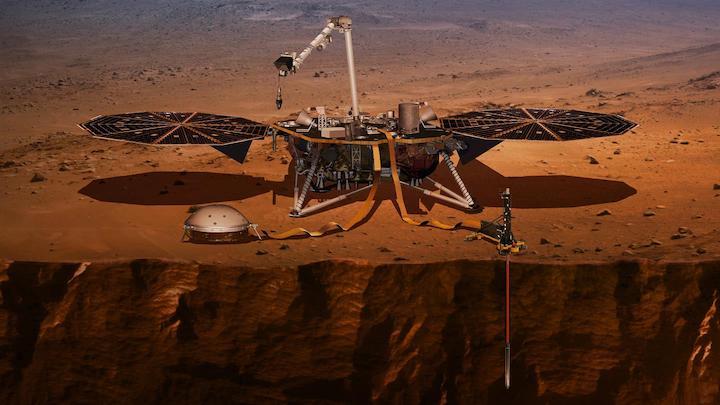
Roughly a century ago, scientists began using earthquakes as a window to our planet’s interior. Decades after that, Apollo moonquake measurements let scientists poke around the Moon’s insides. Now, we’re doing the same on Mars, with some surprising results.
NASA’s Insight mission touched down on the Martian surface in November 2018, and its seismometer (the Seismic Experiment for Interior Structure, or SEIS) has recorded more than 1,000 marsquakes since early 2019. Just a handful of these have been the deeper quakes that scientists are now using to probe the planet’s anatomy.
Reporting in a trio of studies published in the July 23rd Science, the Insight science team has now analyzed about 10 marsquakes to make the first direct observations of the structure within another rocky planet. The results — a surprisingly thin crust, an undifferentiated mantle, and a larger-than-expected core — will help determine how Mars formed and evolved.
THIN CRUST VS. THICK CRUST
Before Insight, scientists were limited to assessing the Martian crust from orbit. Satellites observed the gravitational pull as they circled the planet, which would increase slightly as they passed over thicker crust. Those measurements gave a sense of the relative thickness of the crust, but marsquakes had the potential to make the first absolute measurement.
But measuring marsquakes wasn’t just a matter of sending a lander to Mars; in a sense, the scientists also had to wait for the planet to come to them.
“If you're waiting for quakes; you need to wait until a quake occurs,” says team member Simon Stähler (ETH Zurich, Switzerland). “Of course, when you're in the middle of the situation, it can feel as if ‘Oh my god, it's not working!’”
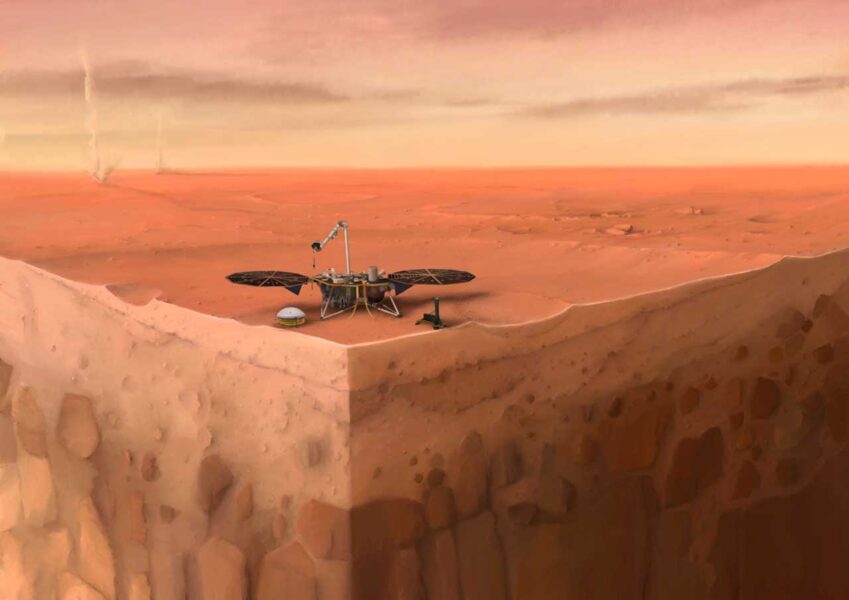
IPGP / Nicolas Sarter
“It was certainly very exciting (and at times tense) to wait for the first seismic event to be detected by InSight on Mars,” says Brigitte Knapmeyer-Endrun (University of Cologne, Germany), co-investigator of the SEIS instrument. That event was announced on April 23, 2019 — but it wasn’t even the right kind. The team had to wait several months after the seismometer’s deployment before a shake occurred at a low-enough frequency that indicated it was had traversed the crust’s full extent.
But that one quake already showed what additional deep quakes would confirm: The crust was thinner than expected.
Just how thin remains an open question. At first, analysis seemed to show that the Martian crust had two layers and was only 20 kilometers (12 miles) thick beneath the Insight lander. “This was thinner than any models had predicted,” Knapmeyer-Endrun says. Additional events and analysis showed that the crust could have an additional layer, making it twice as thick (39 km), somewhat closer to expectations. (Both options are on the thin end compared to Earth’s continental crust, which is typically 35 to 70 km thick.)
Insight data cannot yet distinguish between the two possibilities. “We are definitely hoping to resolve the ambiguity, either by analyzing more data or by using new methods to analyze the existing data, but we are not there yet,” Knapmeyer-Endrun adds.
Though the crust only makes up the top 1% or so of Mars, its exact thickness would shed light on the planet’s formation. As the first part to solidify as the completely molten planet cooled, the crust carries the “memory” of that early time in its composition. A thin crust would have to have an unexpectedly high proportion of radioactive, heat-emitting elements. Gamma-ray spectroscopy from orbit has shown that the surface is not so highly enriched in radioactive elements, so they’d have to be buried deeper in the crust, just above the mantle. The radioactive composition of a thicker crust, on the other hand, would match surface observations.
“If the thinner crust proves to be true, it would be very surprising indeed,” says Doris Breuer (DLR, Germany), who was not involved in the study. “A thin crust will raise many questions about how it was formed and what this means overall for the thermochemical evolution of Mars.”
GOING DEEP
Compared to the relatively thin crust, Amir Khan (ETH Zurich, Switzerland) and colleagues find that the mantle of Mars extends much deeper, down to 400 to 600 km (about twice as deep as on Earth, relatively speaking). What’s more, marsquakes show it’s a simple, undifferentiated structure.
There are two layers to Earth’s mantle: the upper one is geologically similar to the mantle on Mars, while the lower one is dominated by bridgmanite, a mineral not stable on Earth’s surface. The transition region between the lower and upper mantles acts like an insulating blanket, keeping the core from losing its heat. Without this lower layer, Mars loses heat from its core more quickly than Earth does.
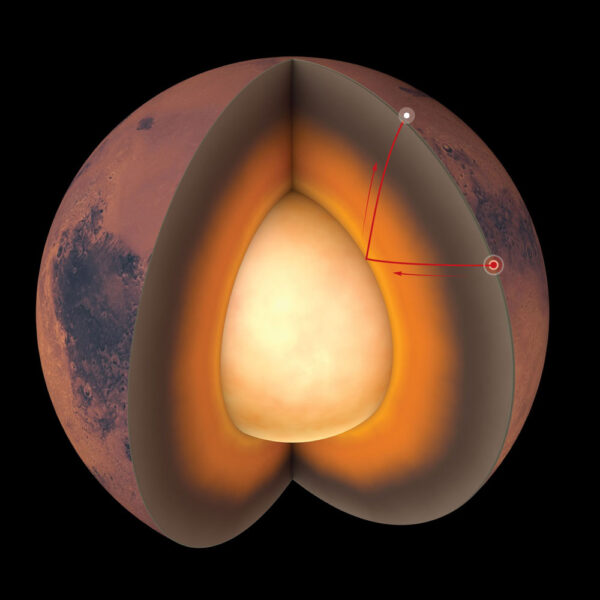
Chris Bickel / Science
Nevertheless, the Insight data show that Mars’s core is still fully liquid, as expected. With the analysis of six marsquakes that were coming in toward Insight at just the right angle, Stähler and colleagues find that the core is on the larger end of what previous indirect measurements had suggested, between 3,580 and 3,740 km across.
Such a large core must be less dense than previously thought, which suggests it contains an unexpectedly high proportion of lighter elements such as sulfur, oxygen, carbon, and hydrogen. A larger, lighter core probably doesn’t have a solid inner part as Earth does.
It may seem surprising that Mars lacks a global magnetic field despite its liquid core. But the dynamos that drive planetary magnetic fields are complicated beasts, and they need to be fed.
Earth’s solid inner core provides that fuel by releasing heat as it crystallizes, which churns the outer core and drives the production of the magnetic field. Mars, on the other hand, probably drove its global field through the release of the intense heat of its formation. That would only have lasted a few hundred million years, consistent with surface observations showing that the global field shut down between 3.7 billion and 4.5 billion years ago.
It’s still possible that Mars's global field could revive under certain conditions, such as if the inner core were to crystallize, or if iron were to “snow out” near the core’s boundaries. But what the future holds for Mars’s magnetism depends on more exact measurements of just how many light elements there are in the core, Stähler and colleagues point out.
CHALLENGES ALONG THE WAY
Insight’s groundbreaking measurements haven’t been without their share of difficulties: First, unlike on Earth and even the Moon, there’s only one seismometer on Mars, which makes triangulating quake sources more difficult.
Second, marsquakes are relatively weak compared to some of those on Earth, and the winds are strong. Scientists learned that the hard way with the failed seismic experiment that sat unshielded on top of the Viking 2 lander. SEIS has a cage around it to block the wind, but even so, quakes are harder to sense during the blustery Martian winters.
Then there were the quakes themselves: Of the more than 1,000 quakes, most were weak and shallow shakes. The useful quakes came from beneath the crust, usually from activity near Cerberus Fossae, a fissured area where the crust is pulling apart. Turns out, the large core creates a sort of seismic shadow, blocking most of the quakes that would come from elsewhere on the planet, such as the Tharsis Rise region.

NASA / JPL-Caltech
(Meanwhile, another Insight’s instrument, the heat probe “mole,” was facing its own share of difficulties, which turned out to be insurmountable. That part of the mission ended last January and it never took complementary measurements of the planet’s heat loss.)
To make maximum use of the marsquakes they did detect, the teams behind all three studies used multiple, independent analysis methods. Stähler credits the unusually large teams with making this possible.
Two-thirds of the scientists, he says, were terrestrial seismologists who had never worked with data from another planet before. “Before the landing, they had ideas of what would work on Mars,” he says. “And then the Martian data was, well, it was different, it was complicated.” The scientists had to scrap some ideas and adapt others in order to look inside Mars.
EXTENDED MISSION
NASA recently extended the Insight mission through the end of next year, past the current Martian winter when marsquakes are difficult to detect due to high winds. Despite a dust-fueled energy crisis earlier this year, the solar-powered lander has since regained some power-generating capacity. “We are at least safe for this season’s winter and probably far into 2022,” Stähler says. During that timeframe, the scientists expect Insight to detect another 10 of the high-quality, low-frequency quakes that enable them to delve deep into the planet.

NASA / JPL-Caltech
Some marsquakes would be particularly exciting to detect: For example, a quake of magnitude 4 or more would help Stähler look for (or rule out) a solid inner core. And a shake moving along the planet’s surface would help Knapmeyer-Endrun resolve the ambiguity about the crust’s thickness by enabling measurements not just at Insight itself but all along the path between the lander and the quake’s epicenter.
Ultimately, only time will tell what the planet will deliver.
Quelle: Sky&Telescope
----
Update: 25.09.2021
.

